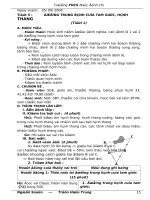- Trang chủ >>
- Mầm non - Tiểu học >>
- Lớp 5
5 6 2 mixed up vegetables (life science)
Bạn đang xem bản rút gọn của tài liệu. Xem và tải ngay bản đầy đủ của tài liệu tại đây (4.38 MB, 12 trang )
Suggested levels for Guided Reading, DRA,™
Lexile,® and Reading Recovery™ are provided
in the Pearson Scott Foresman Leveling Guide.
Life Science
Mixed -Up
Mixed
Vegetables
Genre
Expository
nonfiction
Comprehension
Skills and Strategy
Text Features
• Main Idea and Details • Captions
• Chart
• Compare and
Contrast
• Graph
• Text Structure
• Glossary
Scott Foresman Reading Street 5.6.2
ISBN 0-328-13582-8
ì<(sk$m)=bdfica< +^-Ä-U-Ä-U
by Laura Johnson
Reader Response
1. What is the main idea of the section on pages 16 and
17 titled Pro or Con? Use a graphic organizer like this
one to note details and help you write a main idea
sentence.
Mixed-Up
MixedUp
Vegetables
Detail:
Detail:
Detail:
Main Idea:
2. How do the section headings help you understand
and organize the information presented in this book?
Choose one section and outline the information
covered in it.
3. How many different words in this book come from
the word gene? List them. Then define them. Use a
dictionary, if necessary.
4. Do you think genetic alteration of food is a good
idea? Explain your answer.
by Laura Johnson
Editorial Offices: Glenview, Illinois • Parsippany, New Jersey • New York, New York
Sales Offices: Needham, Massachusetts • Duluth, Georgia • Glenview, Illinois
Coppell, Texas • Ontario, California • Mesa, Arizona
Every effort has been made to secure permission and provide appropriate credit for
photographic material. The publisher deeply regrets any omission and pledges to
correct errors called to its attention in subsequent editions.
Unless otherwise acknowledged, all photographs are the property of Scott Foresman,
a division of Pearson Education.
Photo locators denoted as follows: Top (T), Center (C), Bottom (B), Left (L), Right (R),
Background (Bkgd)
Opener ©Mark E. Gibson/Corbis; 1 ©Ed Young/Corbis; 3 ©Mark E. Gibson/Corbis;
5 ©Pierre Vauthey/Corbis; 7 (B) ©Niall Benvie/Corbis; 8 ©Ed Young/Corbis;
10 ©Anthony Bannister; Gallo Images/Corbis; 11 ©Bill Ross/Corbis; 13 ©Spencer Jones/
PictureArts/Corbis; 15 ©Doug Wilson/Corbis; 17 © Michael and Patricia Fogden/Corbis
ISBN: 0-328-13582-8
What Are Genetically Altered Vegetables?
What happens when you cross a cold-water
fish with a tomato? You get a tomato that can
swim. Actually, it is no joke that you get a new
tomato that can grow in very cold weather. You
see, most tomatoes grow best in warm weather.
Arctic flounders are fish that live in very cold water.
Scientists took a gene from an arctic flounder and
put it into a tomato. That way they could test to see
if tomatoes could grow in cold weather.
This is a strange example of a test done by
scientists to try to create a genetically altered
vegetable. Genetically altered means that a change
has been made to a plant or animal’s genetic
makeup. Many vegetables, such as the coldweather tomatoes, are still in the testing stages.
Many genetically altered vegetables, such as corn,
tomatoes, broccoli, and carrots, are sold in stores.
All living things have genes. Genes tell what living
things will look like. Your genes determine your hair
color, eye color, and your height. Genes in plants
determine their color, size, and flavor. Every cell has
genes.
Copyright © Pearson Education, Inc.
All Rights Reserved. Printed in the United States of America. This publication is
protected by Copyright, and permission should be obtained from the publisher
prior to any prohibited reproduction, storage in a retrieval system, or transmission
in any form by any means, electronic, mechanical, photocopying, recording, or
likewise. For information regarding permission(s), write to: Permissions Department,
Scott Foresman, 1900 East Lake Avenue, Glenview, Illinois 60025.
2 3 4 5 6 7 8 9 10 V0G1 14 13 12 11 10 09 08 07 06 05
3
Why Mess with Nature?
Many people believe that altering food can be
beneficial in solving the world’s food shortage. They
say that these foods can be grown in cold or dry
weather. This allows farmers to grow much more
food.
Other people believe that altering food is a
mistake. They feel that these new foods should be
better tested for safety. They worry about possible
harm to people and the Earth.
As you read, you will learn how farmers and
scientists have genetically altered vegetables. You
will learn how plants can be changed and what
changes are being made today. You will also learn
the reasons for such changes.
Is Changing Plants a New Idea?
Farmers have been changing plants to make
them better for years using two methods: selective
breeding and grafting. In selective breeding, a
farmer chooses specific plants that have good
features, such as good taste or being able to live
with very little water. The farmer can then breed two
plants together to make a new plant that has both
of those good traits. Selective breeding can only be
done with plants that are closely related, such as two
types of corn. It often takes several years for changes
to happen.
Grafting is attaching a piece of one plant to
another so that the two pieces can grow together
into one plant. For example, an apple tree might
hold up in very cold weather, but have weak
branches. The roots and trunk of that tree could be
attached to an apple tree with strong branches. The
result would be a strong apple tree that can survive
in the cold.
A researcher grafts two plants together.
4
5
Why Alter Food Genetically?
Today, the most common way of genetically
altering food is called genetic engineering. Scientists
change or add genetic material to the plant’s cells.
The food produced from genetically altered plants
is called genetically modified food. The diagram
on page 8 describes how certain plants have been
improved through genetic modification.
About thirty years ago, scientists learned how
to inject genes from one life form into a totally
different one. This is called genetic engineering. It is
an improvement on selective breeding and grafting
because through those methods, only traits that
already exist in plants can be bred into new ones.
For example, a potato cannot be bred to fight off
leaf-eating pests, because no potato plants have
that trait. Through genetic engineering, however,
scientists can take genes from plants that have
chemicals that protect them from insects and put
them into potato plants. The result is a new potato
plant that can make chemicals that will protect it
from insects.
These newly created plants are called transgenic
organisms. Transgenic organisms contain genes that
have been artificially added.
Pests are a big problem for farmers.
6
7
8
Crop
Improvement
Broccoli
Ripens slower, stays green longer
Cabbage
Resists attacks by caterpillars
that eat its leaves
Celery
Stays crisp longer
Cucumbers
Resist disease and fungus
Potatoes
Resist leaf-eating pests, such as
caterpillars and beetles
Eggplants
Have fewer seeds
Soybeans
Have greater nutritional value;
more protein
Artichokes
Resist viruses and bacteria
that cause disease
Tomatoes
Ripen more slowly; resist rot
and frost; have improved taste
More than forty kinds of genetically altered crops
are sold today. The chart on page 8 shows some
examples.
9
What Good Are Genetically Altered Vegetables?
Genetically altered vegetables are scientific
marvels. They can grow in less space and can grow
faster. As a result, three crops of genetically altered
lettuce can grow in the same amount of time it took
to grow two crops of regular lettuce. This can help
feed the growing world population.
Genetically altered vegetables can also be
modified to grow in different climates. Crops that
grow in warm places can be altered to grow in cooler
places. Likewise, plants that grow in cool places can
be altered for warmer climates. Vegetables can also
be changed to live without water, for a time.
Many farmers use pesticides to kill insects. Plants
can be altered to resist pests. A pest called the corn
borer kills huge crops of corn. Scientists knew about
a bacteria in soil called Bt. Bt has a gene that makes
a poison that kills insects. They put this Bt gene into
corn plants. The result was corn that makes its own
poison to fight off the corn borer. This lowers the
need for pesticides that pollute air and water.
10
Genetically altered vegetables can fight
off insects that harm or kill crops.
Many fruits and vegetables have been genetically
modified to make them look and taste better. One
of the best examples of this is the Flavr Savr tomato.
To create the Flavr Savr tomato, scientists changed a
tomato gene to make a new feature. They didn’t add
any genes to the tomato.
Tomatoes that ripen on the vine taste best, but ripe
tomatoes are soft. Ripe tomatoes bruise and tear when
they are picked and shipped to stores. As a result,
tomatoes are picked and packed when they are firm
and green, not red and ripe. Then they are ripened
with a special kind of gas. This alters their taste.
Scientists changed the gene that makes tomatoes
ripen. Flavr Savr tomatoes ripen on the vine, but they
do not get soft. They have that ripe flavor, but they
don’t bruise as easily. Flavr Savr tomatoes were the first
kind of genetically altered food to be sold in stores.
11
U.S. use of genetically engineered crops
90
Percent of planted area
80
70
Vegetables Really Are Good for You!
Some vegetables may be new to you. Soybeans
have been genetically modified to become more
nutritious. Soybeans are a good source of protein,
which our bodies need to grow and heal. Scientists
have created genetically altered soybeans with even
more protein.
Tomatoes contain lycopene, which helps fight
cancer, blindness, and heart disease. Genetically
modified tomatoes have been created that have
twice as much lycopene as unaltered tomatoes.
60
50
40
30
20
10
0
1996
1997
1998
1999
2000
2001
2001
2003
Year
Soybeans
Corn
Cotton
As the graph shows, there is a lot of
genetically modified corn and soy.
You might be surprised to learn that
soy is in many things you eat.
12
Some genetically
modified foods, such as
these soybeans, taste
better, look better, and
are more nutritious.
13
Scientists are attempting to genetically alter foods
to carry vaccines and medicine. Vaccines prevent
diseases. In 1998, scientists began to genetically
alter potatoes that contain a vaccine that prevents
a disease that causes severe stomachaches. Testing is
also being done with transgenic spinach. Researchers
are trying to grow spinach with a vaccine for rabies.
Neither of these altered foods is ready for humans to
eat yet.
We don’t know how many genetically altered
vegetables are grown or sent to market at this time.
We do know that some of the potatoes, corn, and
soybeans grown and sold in the United States come
from transgenic crops. How do you know if you are
buying a transgenic vegetable? You probably will
find it hard to find out. In this country, there is no
law requiring that labels tell whether the foods are
genetically modified.
From looking at them, can you tell if these plants
are genetically altered?
Potatoes and spinach are two
of the foods that scientists are
trying to modify to contain
medicine or vaccines.
14
15
Pro or Con?
There is much debate about the genetic alteration
of vegetables. Many people believe the process is
helpful.
Others believe that genetically modified
vegetables and other foods are a big mistake. The
following are some of their reasons:
• Pests can become resistant to genetically altered
poisons. Scientists put poison into cotton crops to
protect them from cotton borers. But the poison
didn’t kill all the insects. The remaining insects were
resistant to the poison and bred more resistent
insects. As a result, crops in some areas
were killed by cotton borers that were
resistant to the poison.
People are afraid that
this might be a problem
as more pests become
resistant to pesticides.
• Transgenic plants are a danger to
wildlife. Scientists found that the poison
put into corn to make it pest resistant
killed the caterpillars that become monarch
butterflies. The caterpillars eat the milkweed
that often grows near corn crops. When pollen
from transgenic corn blows around, it lands on
the milkweed. The caterpillars eat the pollen
along with the milkweed. In just a few days,
the caterpillars die. Many people fear that
more wildlife may be killed in the same way.
16
• Transgenic vegetables have caused allergies and
health problems. Some transgenic vegetables have
caused health problems. Some people who handled
transgenic celery got severe skin rashes. Doctors
found out that the altered celery had a chemical that
caused these rashes. Crops of these vegetables are no
longer grown, but people fear that new transgenic
foods will cause other health problems.
• Genetically modified foods need more testing.
Many people believe that transgenic foods have
not been tested enough. In this country, the U.S.
Department of Agriculture (USDA) makes the testing
rules. New rules have shortened the foods’ testing
time. People fear that shortened test times could
lead to mistakes.
• Genetically altered foods are not needed to
feed the world’s growing population. Many people
believe that the crops that already exist can feed the
world. They feel that selective breeding can produce
more food more safely. They also say that we need
to find better ways to send food to the hungry. They
say these measures will cut the need for genetically
altered foods.
17
Now Try This
Working in a small group, write an information
sheet about genetically modified vegetables.
Brainstorm information and opinions to be included.
One group member can record the facts and
opinions. Then poll classmates about pros and cons
of genetic engineering.
to Do It!
w
o
H
s
’
e
r
He
1. Begin by writing facts about genetically modified
vegetables. Do not include opinions in this
section. List facts about vegetables that have been
genetically modified and why.
2. Then list four opinions that support the idea
that growing these vegetables is beneficial. Write a
heading for this section.
3. Next, list four opinions that support the idea
that growing these vegetables is a mistake. Write a
heading for this section.
4. Share your findings with the class.
5. Finally, ask the class to vote if they are for or
against genetic modification. List the totals on a
sheet of paper and share them with the class.
18
19
Glossary
Reader Response
beneficial adj. good or
useful.
pesticides n. chemicals
that kill insects.
gene n. a tiny unit in
each cell that influences a
characteristic or trait.
transgenic organisms n.
plants or animals that
contain genes that have
been artificially inserted.
genetically altered adj.
having had genes added
to change a trait.
1. What is the main idea of the section on pages 16 and
17 titled Pro or Con? Use a graphic organizer like this
one to note details and help you write a main idea
sentence.
Detail:
Detail:
Detail:
Main Idea:
2. How do the section headings help you understand
and organize the information presented in this book?
Choose one section and outline the information
covered in it.
3. How many different words in this book come from
the word gene? List them. Then define them. Use a
dictionary, if necessary.
4. Do you think genetic alteration of food is a good
idea? Explain your answer.
20









